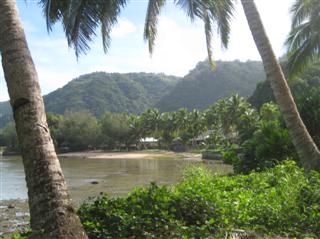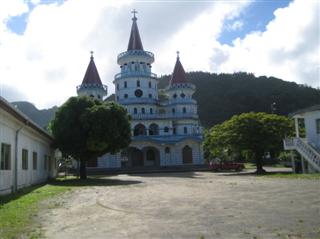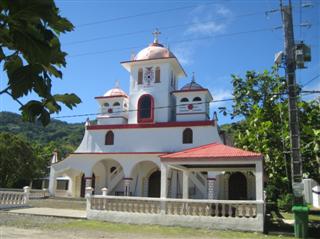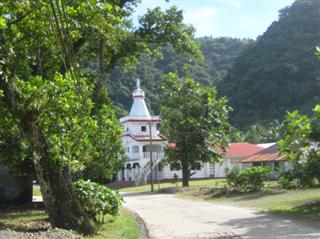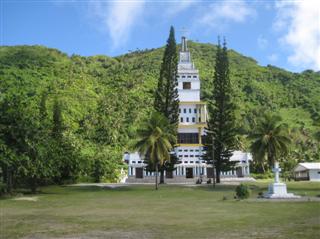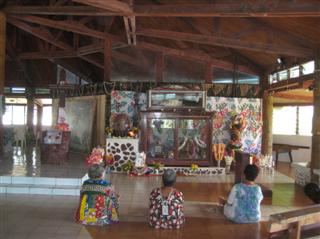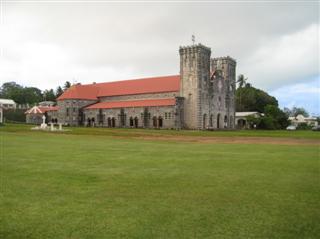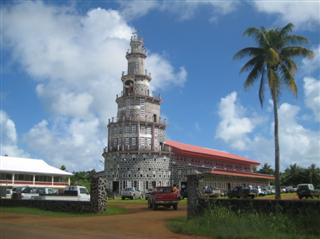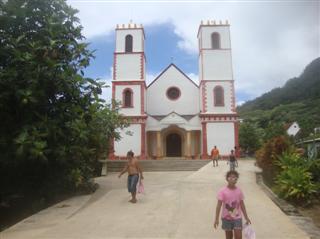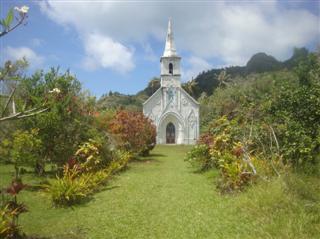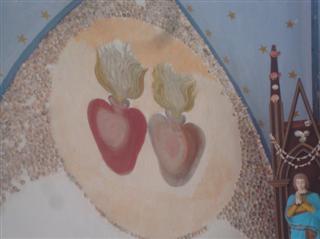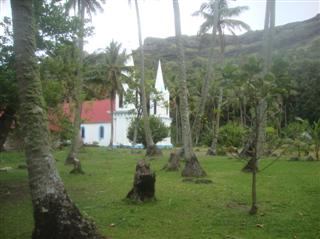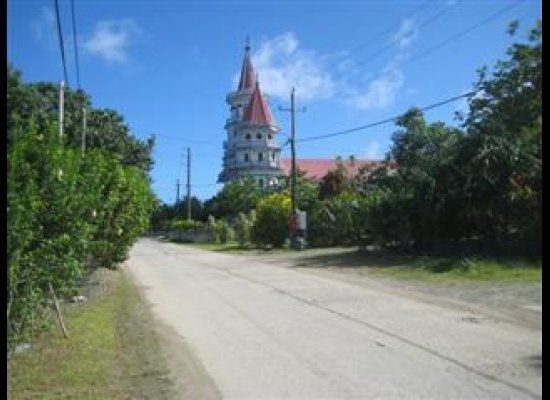If you travel to some of the remotest islands of Polynesia, churches are probably not uppermost in your mind -- sensuous wahines perhaps, slowly gyrating grass-skirted hips, lilting music, Edenic beaches, but churches? Yet they are among the more striking sights you'll find on the furthest-flung islands in the South Pacific.
It's hard to get further away from anywhere than Futuna, the mountainous 32-square-mile speck of land that forms part of the French overseas collectivity of Wallis and Futuna. The jungle-clad island is still divided into two traditional kingdoms -- Alo and Sigave -- that are fortunately no longer mostly at war, and its only link with the outside world is by small turbo-prop plane and the occasional ship to Wallis, about 150 miles to the north-east and itself pretty far off the traveller's beaten track.
Typical Futuna scene
But if you brave the distance and airline schedules, you'll be amazed by the fanciful stone churches that now grace the bays and hills of an island whose warrior inhabitants are credited with allegedly woolfing down the whole population of the nearby islet of Alofi in one cannibal sitting in the 19th century.
In Sausau, a stone's throw from Leava, the island's main town and capital of Sigave, a triple towered semi-pagoda-like church adorned with red turrets and baby blue balustrades rises on a leafy headland against precipitous green escarpments and a craggy mountain backdrop -- straight out of Disney's Magic Kingdom.
The 'Disneyland' church at Sausau
All around the island's coast, past modern shacks but also many traditional sloping straw-roofed open sided oval houses that the men use for their meetings, ornate stone churches with towers, steeples and statues dot the flowery shores of bays and coves. One even has domes and openings in turrets that look like clown's eyes, or even those of a cat above lines that could be feline whiskers.
The 'cat's eyes' church
Another of Futuna's fantasy churches
But in a blow to beauty, at least in the eyes of this beholder, near the hamlet of Poi on the north-eastern side of the island, where the escarpments are even steeper and greener and the shore peppered with craggy outcrops, rises a monstrosity that pays homage to Pierre Chanel, French Catholic martyr and first saint from Oceania.
Pierre Chanel church
Pierre Louis Marie Chanel, the first missionary to set foot on Futuna, was initially welcomed by King Niuluki in 1837. But he was clubbed to death in 1841 after Niuluki apparently got pissed off with his growing influence when he baptised the king's own son and daughter.
His shrine is a veritable monument to ugliness, rearing upwards 100 feet or more amid the glorious jungle mountains, in the tiers of a Stalinist Gothic wedding cake, with yellow and blue columns. Its cavernous interior is adorned with ugly plain coloured glass windows.
Interior of Pierre Chanel church
In a bluish-roofed round side chapel the faithful come to pray for miracles before his relics displayed in a glass cabinet, including silver cases containing his clothes and the club that presumably dispatched him to sainthood.
Supplicants sit before St Pierre Chanel's relics
On Wallis the Cathedral of Our Lady of Good Hope on the waterfront of Mata'Utu, the capital, right next to the king's bungalow-style palace -- Wallis consists of just one kingdom, Uvea -- lacks Futuna's whimsy but it does present a stolid stone front with a Maltese Cross, the king's royal arms, on its facade.
Cathedral in Mata'Utu
A rural cousin, though, more than makes up for what Our Lady lacks in fancifulness.
The rural cousin
More than 3,000 miles to the southeast in the Gambier Archipelago, at the farthest extreme of French Polynesia, another French Catholic missionary, a certain Honoré Laval, a much less gentle gentleman than St. Pierre Chanel, was hell-bent on converting the heathens to Catholicism about the same time that Pierre was first converting, then being converted into a saint by being clubbed into the martyrs' club.
Laval smashed all the maraes (religious platforms) and idols on the 11 islands in the vast turquoise lagoon that is surrounded by a 55-mile long coral reef topped by sandy green motus (islets). He then built a collection of Catholic churches in their place, using thousands of islanders as slave labourers. Thus he not only destroyed their culture, but collaborated along with European diseases to their decimation, according to some. Today there are only about 1,600 people living on all the islands.
View of Mangareva from Aukeni across Gambier lagoon
But his legacy lives on. Enveloped by the verdant escarpments of Rikitea, capital of Mangareva, the magnificent volcanic outcropping with twin 1,500-foot peaks that is the main island, the twin-towered cathedral of St. Michel stands on the smashed remains of the royal marae.
It's not far from where another gift from France once stood before being pulled down a few years ago, the Maison Nucléaire, the rusty old nuclear fall-out shelter the French herded the islanders into every time the wind blew the wrong way during their 1966-74 atmospheric atomic tests on Mururoa atoll, just 250 miles across the Pacific to the west.
St. Michel cathedral
Similar churches with sloping roofs and traditional facades and spires, a straight-laced far cry from Futuna's whimsy, adorn the other now depopulated islands, set on green clearings amid tall leafy trees and verdant flower-bordered paths, recalling nothing so much as some peaceful corner of rural France.
On Taravai, a half-hour boat ride from Mangareva, the red roof and single white tower and facade remain even if the population has long since disappeared. Thanks to European diseases and Laval's forced labour there are now only five people living on Taravai for a church built for hundreds. Pilgrimage services are held twice a year when people flock over from Mangareva.
Taravai church
Inside, Yours Truly shocks the guide. Well, how am I to know that the blood-red splotches above the altar are not strawberries, but the sacred heart?
Taravai 'strawberries'
On Aukeni island, across the lagoon from Mangareva's towering peaks, there's a simple little blue-trimmed white church with no spire at all, but Akamuru island makes up for that with the twin towers of a beautiful red-roofed sanctuary, blindingly white with blue trim amid lush palms beneath the beetling cliffs.
Akamuru church
So if you want to commune with your maker far from the main tourist highways and byways, even by French Polynesian standards, you have a few options before you.
For more travel experiences see www.looneyfront.blogspot.com
Also by the same author, Shakespearean spoofs on current day politics at www.shakespeareredux.blogspot.com
